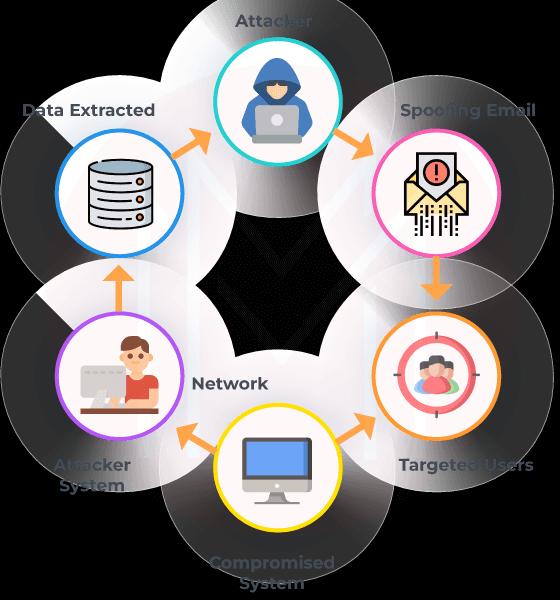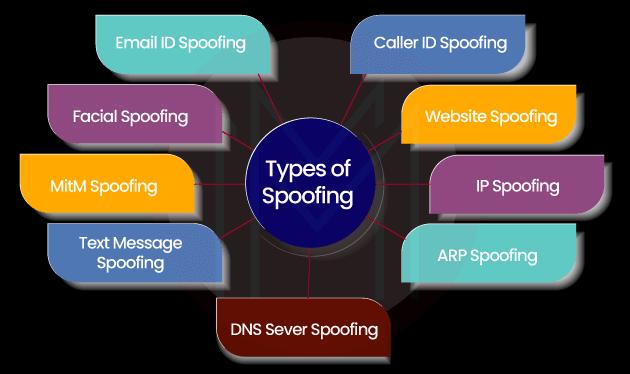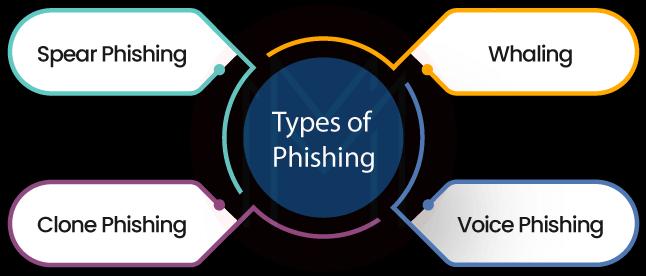- Home
- Blog
- Cyber Security
- Spoofing vs Phishing

- Cyber Security Career Path
- Cyber Security Certifications
- Cyber Security Frameworks
- Cyber Security Interview Questions
- Cyber Security Threats and Prevention Methods
- Top 10 Cyber Security Tools In 2024
- How to Become a Cyber Security Engineer
- Reasons to Learn Cyber Security
- Cyber Security Best Practices
- What is Cyber Security?
- New Technology Trends in 2024
- Penetration Testing Interview Questions
- Network Security vs Cyber Security
- What is Penetration Testing?
- Bug Bounty Interview Questions
- CRISC VS CISA
- Cyber Security VS Data Science
- Cybersecurity Projects and Use Cases
Be it an individual or an organization, they use computers for all their crucial tasks, including money transfers, sending confidential information through emails, and many more. So, protecting computers from cyberattacks becomes inevitable since cyber-attacks cause severe damage to computers and make financial loss. Therefore, knowing different types of cyberattacks is essential to encounter them successfully, thereby protecting your valuable systems and money.
Spoofing and phishing are the two Cyberattacks made by cyber criminals to cause financial loss and make attacks such as Distributed Denial of Services (DDoS), bypassing networks, etc. To do so, first of all, they steal the identity of the targets and launch attacks through various communication channels such as emails, phone calls, SMSs, etc. Note that, in this context, target means an individual or organization.
Although both attacks are made to cause severe harm to their targets, there are many differences between them in how they make attacks and cause damage. This blog dissects the two techniques on a deeper level and provides you with a clear-cut idea about the two.
Are you curious to know the nuances of Spoofing vs Phishing? Let’s continue reading the blog.
| Table of Content - Spoofing vs Phishing |
What is Spoofing?
In spoofing, the attack is specific and includes all kinds of damages. Attackers gather the background information of targets through their websites or social media accounts. Then, they send fake emails or make calls to targets as if the emails or calls are coming from trusted sources. For example, targets would receive emails as if their boss or bank sent them. By replying with confidential information, clicking the links, or downloading attachments, targets will be victimized and allow attackers to gather crucial information such as logins and passwords. Simply put, attackers commit identity theft and achieve their objectives after that.
Through spoofing attacks, attackers not only aim to make a financial loss to their targets but to infect their systems and networks with malware, flooding target systems with a volume of messages and ultimately spoiling their reputation. Also, attackers can bypass network access controls of the targets or redistribute traffic for DDoS attacks. As attackers could manipulate network access controls, they can even attack the vendors and clients of the targets. Not only limited to this, attackers can also make large-scale attacks such as ‘advanced persistent threats and ‘man-in-the-middle’ attacks.
| If you want to enrich your career and become a professional in Cyber Security, then enroll in "Cyber Security Training". This course will help you to achieve excellence in this domain. |
How Does Spoofing Work?
Spoofing is a kind of attack where attackers use fake email addresses, text messages, phone numbers, names, and web page URLs to deceive targets as if they are communicating from known or trusted sources. Know that attackers create fake addresses very similar to original addresses. To do so, they just change a single letter or number in the trusted sources' email addresses, IP addresses, phone numbers, etc. Once the target is convinced by clicking the links and downloading the attachments that come along with the emails or messages, immediately malware will be installed in the system, causing severe damage to systems and networks.

For instance, consider you the target of an attacker. The attacker may send you an email as if it is coming from Amazon, intimating that you have a problem with your recent order. In the email, the links and attachments will look like the original ones if we look at them at a glance. And the email may suggest that you need to enter the order details once again in the attached link. Once you click the attached link and re-enter your login and password, you will be victimized and vulnerable to attack.
| Related Article: What is Cyber Security? |
What is Phishing?
Phishing is the term derived from the word ‘fishing’. As the name indicates, attackers try to ‘fish’ the possible targets from a group of people or organizations. Know that spoofing is the subset of phishing attacks. Because of this, Phishing can use some spoofing techniques. Like spoofing, attackers act like they are communicating from trusted sources and tactfully gather the targets' personal information. Attackers mainly do phishing for data theft and to cause financial loss to the targets, whereas attackers aim at damaging the systems and networks and reputation of targets in spoofing.

How Does Phishing Work?
Unlike spoofing, attackers don’t target selected people or organizations; instead, they aim at a group of people or organizations. Those deceived by the phishing techniques of attackers will ultimately lose their identity information and money. In other words, attackers may send fake emails, messages, etc., to targets with links and attachments as if they are communicating from trusted sources. And whoever opens the attachments and links accompanying phishing emails will be victimized.
However, phishing is carried out by emails and SMSs most of the time, whereas spoofing is achieved in multiple ways – through IP addresses, DNS servers, caller IDs, and so on.
For example, attackers may send phishing emails to a group of targets as if it is sent from trusted sources such as Facebook or Amazon to gain the targets' trust. Once the target opens the email and clicks the links or downloads attachments, the target’s system gets compromised and might be installed with malware. So, it leads to the attacker stealing the target's personal information. Or else, attackers may ask the targets to enter their personal information on the fake websites of Amazon or Facebook, by which they collect the credentials of the targets and use them for fraud purposes.
Types of Spoofing and Phishing
What are the Types of Spoofing?
Many methods are followed by attackers to make spoofing. Let’s understand them below:

1. Email ID Spoofing: In this type of attack, Attackers use emails to deceive targets like they are sent from trusted sources. Usually, these emails will have false sender addresses. For example, targets may receive emails as if they are sent from their CEO or CFO asking for money transfers or credentials. The emails would have the fake logo, fonts, call-to-action-buttons, colours, etc., like the trusted sources. Besides, the emails will contain links to malicious websites and attachments with malware.
2. Caller ID Spoofing: Attackers use phone calls to deceive targets. Targets would receive phone calls as if they were coming from known or trusted sources. Once the targets are convinced of the fake calls, attackers collect crucial information such as login IDs, social security numbers, passwords, etc.
3. Website Spoofing: Attackers recreate websites like the original or trusted sources using this spoofing technique. Targets will be directed to these websites to enter their personal and sensitive information. In addition, these websites can also install malware on the target’s system.
4. IP Spoofing: Attackers hide their original identity or location by creating spoofed IP addresses as if the original IP addresses of trusted sources. Here, the header of the spoofed IP address will be different from the actual IP address. With these spoofed IP addresses, attackers can quickly enter and harm the targets' networks. Mainly, IP spoofing aims at making DDoS attacks and Man-in-the-Middle attacks. This spoofing could freeze the entire activity of targets – not even allowing them to make alerts about the attacks. Know that IP spoofing can bypass the tools that block fake IP addresses.
5. ARP Spoofing: Attackers link their Media Access Control (MAC) with the target’s IP addresses. So, they can redirect all the incoming messages of the target’s IP address to attackers.
6. DNS Server Spoofing: In this spoofing, attackers direct the target’s IP address to the IP addresses that spread malware.
7. Text Message Spoofing: It is also referred to as smishing. In this spoofing, the target will receive text messages like they are coming from trusted sources. The message will have links and attachments to trap the targets.
8. MitM Spoofing: It is known as Man-in-the-Middle spoofing. Like eavesdropping, attackers intercept the communication between two parties hiddenly. Here, either one or both parties could be the targets. By this spoofing, attackers easily gather personal and sensitive information and attack the targets.
9. Facial Spoofing: In this attack, attackers hide their original identity and use the photo or video of a known person to deceive the targets.
| Related Article: Top Reasons to Learn Cyber Security |
What are the Types of Phishing?
Like spoofing, attackers use many methods to make phishing attacks. Let’s discover more about them:

1. Spear Phishing: This attack is usually made against an individual or company. And attackers involved in this attack to achieve financial gain or gather business secrets. Before making this attack, attackers collect the background information of targets through the social media accounts or company websites of the targets. Then, attackers frame emails as if they are sent from trusted sources and seem to be authentic. For this, they include the name and location of the targets in the email.
2. Whaling Phishing: This attack is usually made against the senior executives of companies, and it is mainly carried out to make financial frauds. Before sending emails to the target, attackers do good research about the target and use authentic details in the emails to convince the target. For instance, they may frame emails as if their suppliers are asking for payments with authentic details.
3. Clone Phishing: In this type of phishing, attackers use previously used emails that may contain links or attachments. Then, the attackers replace these links and attachments with malicious ones to attack the targets.
4. Voice Phishing: In this phishing type, attackers send fake voice mails to the targets through Plain Old Telephone Service (POTS) or Voice over IP (VoIP) techniques as if it is sent from a known person. By this technique, attackers collect the personal credentials of targets and commit financial frauds.
| Related Article: Top Cyber Security Interview Questions and Answers |
Can we detect and prevent spoofing and phishing attacks? Why not? There are plenty of methods to detect and prevent the two. The following sections will explain the same.
Spoofing vs Phishing: Detect and Prevent
How to Detect and Prevent Spoofing?
The following pointers will help you detect spoofing in your systems. Let’s now look at them below:
Detecting Spoofing
- Check the spelling in the content of emails and other communication forms, which would definitely have errors.
- Check the sentence structure and grammar in the content, which might be incorrect and inconsistent.
- Check the URLs of the web pages of senders, domains, and email addresses, which may have slight changes from the trusted sources’ email addresses and webpages.
- You may copy and paste the contents of emails or other contents and then google it, which will help you check whether it is a spoofed one.
- Websites with no lock symbols and URLs with no HTTP or HTTPS might be spoofed.
Spoofing Prevention Methods
Following are the battle-tested prevention methods that will help you to prevent spoofing. Let’s see what in below:
- If you receive any emails with suspicious links and attachments, do not click or download them. Instead, you can reply to those emails asking for more details for confirmation. Or else, you can open the website in a new tab by copying the original link.
- You can use a reliable email security gateway. For example, the Sender Policy Framework (SPF) is one of the authentication protocols that can be used to prevent unauthorized emails.
- You can turn on the ‘email spam filter’, which supports filtering spoofing emails.
- You shouldn’t attend phone calls immediately based on face values all the time. Suppose you are suspicious about any calls you have received, then you can verify the caller ID by googling it. It will help to identify whether it is associated with any spoofing activities or not.
- In case you receive any calls asking for personal information, you shouldn’t respond to them immediately. But, you have to contact the relevant customer support and authenticate the call.
- You can make the Windows settings to view the file extensions of files, which will help prevent malicious files from loading into your systems.
- You can install reputed cybersecurity software and update them frequently.
- With the reverse IP lookup technique, you can authenticate senders thoroughly.
- It would be best if you allowed auto-fulfilling only for the known websites.
| Related Article: Cyber Security Threats and Prevention Methods |
How to Detect and Prevent Phishing?
Detecting Phishing
The following are the methods used to detect phishing attacks significantly. Let us see them below:
- Phishing emails would have misspelled URLs and subdomains.
- Content in the email would have typos and grammatical mistakes.
- Senders usually use public email addresses instead of using corporate email addresses.
- The message that they have sent may have content that induces fear or urgency.
Phishing Prevention Methods
Following are the methods used to prevent phishing attacks. Let us see them below:
- It would be best if you used reputed Antispyware software.
- Robust network and desktop firewalls help prevent phishing emails.
- You can use antifishing toolbars to prevent phishing emails.
- You can use gateway email filters and web security gateways.
- DMARC is the protocol that can be used to prevent unsolicited emails effectively.
- The amount of personal information you have put in place on the websites and social media must be limited – Or must have only essential details.
- Extensive security awareness training programs must be conducted for employees on behalf of companies.
- If you suspect any link for making online payments, you can open the payment portal in a separate tab and then make the payment safely.
Conclusion
In the simplest terms, spoofing attacks are made to make a financial loss, assets loss, and financial loss for the targeted people and organizations. On the other hand, phishing is made to make financial frauds most of the time, and it is a common attack against a group of people or organizations but not specific. By going through this blog, we are confident that you might be clear about the difference between spoofing and phishing. Hopefully, this blog will help you make suitable preventive measures against spoofing and phishing and secure your valuable money and assets.
 On-Job Support Service
On-Job Support Service
Online Work Support for your on-job roles.

Our work-support plans provide precise options as per your project tasks. Whether you are a newbie or an experienced professional seeking assistance in completing project tasks, we are here with the following plans to meet your custom needs:
- Pay Per Hour
- Pay Per Week
- Monthly
| Name | Dates | |
|---|---|---|
| Cyber Security Training | Jan 17 to Feb 01 | View Details |
| Cyber Security Training | Jan 20 to Feb 04 | View Details |
| Cyber Security Training | Jan 24 to Feb 08 | View Details |
| Cyber Security Training | Jan 27 to Feb 11 | View Details |

Viswanath is a passionate content writer of Mindmajix. He has expertise in Trending Domains like Data Science, Artificial Intelligence, Machine Learning, Blockchain, etc. His articles help the learners to get insights about the Domain. You can reach him on Linkedin















